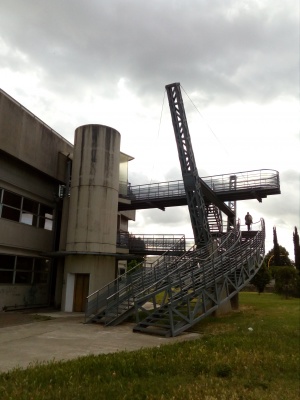Il Giardino di Archimede
| Il Giardino di Archimede | |
|---|---|
| City | Florence |
| Country | Italy |
| Opening year | 1992 (first exhibition in Pisa) 1999 (Priverno) 2004 (current location in Firenze) |
| Exhibition surface | 1000 m2 |
| N. of exhibits | 60 |
| N. of visitors (yearly) | 13 000 |
| Address | Via San Bartolo a Cintoia 19a 50142 Firenze (Italy) |
| Web | http://web.math.unifi.it/archimede/ |
Il giardino di Archimede (The garden of Archimede) was a math museum in Florence (Italy), opened from 2004 to 2020. It will open a new location in 2022 in the nearby town of Pistoia.
Contents
Sections of the museum
The museum is divided into thematic exhibitions, which have normally existed previously as temporary installations. The different sections are physically in different rooms and they can be visited independently.
These exhibitions are: Beyond the compass, about the geometry of curves; A bridge over the Mediterranean, about Leonardo de Pisa (Fibonacci); Pythagoras and his theorem; and Helping Nature, from Galileo’s machines to everyday life, about basic machines such as levers, pulleys and leaning planes.
For schools, groups can visit one or more of the sections and receive specific workshops on each exhibition topic.
The secions are the following:
Beyond the compass
About the geometry of curves.
A bridge over the Mediterranean
About Leonardo de Pisa (Fibonacci), the arab science, and the renaissance of Western mathematics. This exhibition consist only of wall panels, with the exception of some ancient books on display (notably the Liber Abaci from Fibonacci), and a mock-up of ancient Florence with marks on schools and academies where Liber Abaci was taught.
Pythagoras and his theorem
With several puzzles games and sculptures around pythagorean theorem.
Helping Nature. From Galileo's machines to everyday life
About basic machines such as levers, pulleys and leaning planes.
With the exception of "A bridge over the Mediterranean", all the museum is based on hands-on exhibits that visitors can touch and play with. All the exhibits are profusely explained in wall panels, and books with further information are available on the shop for each of the sections/exhibitions.
